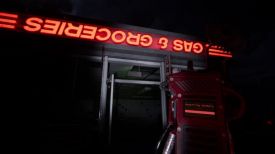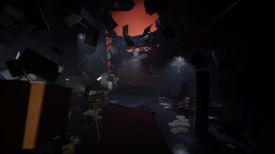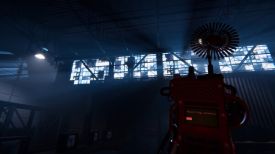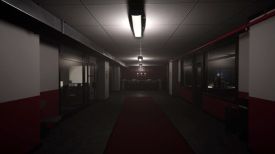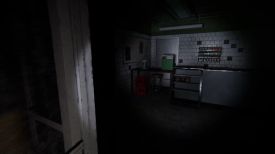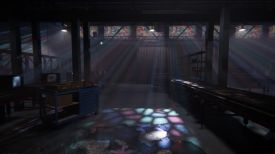|
By flotsam
Shift 87
Pixelsplit/Daedalic
Entertainment
From the same stable that
brought us REVEIL, this game couldnít be more different. In being so, it
wasnít really my preferred cup of tea, but I confess to having had a
better time than I had first anticipated.
Self described as ďan
observation horror game,Ē on the basis of my playtime I would whole
heartedly endorse everything but the horror. The environments are dark
but nothing in my exploration of the three floors has been horrific. A
Ďbooí moment or two and an occasional bit of creepiness is as close as
things come.
So what then do we have? In a
nutshell, it's spot the difference while walking and exploring.
You begin by selecting Ďstart
shiftí from the menu, and you find yourself in what can reasonably be
described as the entry foyer of the Youngstown News office. A voiceover
from your supervisor tells you that your job is to traverse alternate
versions of this environment and report any anomalies. A gizmo to report
the anomalies is present in your hand; press R to generate it at any
time and report.
The office is a small
environment; a short walk down a corridor, turn right, and a similarly
short walk to a lift at the end. There are though rooms you can see into
as you walk, as well as a reception area at the junction. A kind of
waiting area also exists outside the lift.
There is all manner of stuff in
the rooms you can see into, as well as in the reception area. Various
items are also in the corridors and waiting area. All of it matters, or
doesnít.
Your first time through the
environment gives you the baseline - this is what this space looks like
in all its detail. The next time through you are looking for what is
different. There will be something or there will be nothing. If itís the
former, report it and then take the lift. If itís the latter, then just
use the lift.
Whether you are correct or not,
the lift will regurgitate you back onto that same level, and you walk
through it again. Spot the difference this time or decide there isnít
one. Report (or not) and repeat.
Do that correctly six times in a
row and you will change floors, the environment then being different.
Get it wrong and start the level again.
The second environment is a
smallish warehouse, the third a gas and groceries enterprise. Doors
rather than a lift are your entry and exit points for these levels. The
need to explore the latter with a torch makes it a little more
challenging.
There are 22 possible anomalies
in each of the three environments, and to make things more interesting,
they randomly generate as you go. Which means if you fail before getting
six in a row, what then confronts you can be completely different. The
fact that there might not be an anomaly each and every time adds another
layer to the complexity.
What also adds to the challenge
is that you canít save. The game keeps track of how many anomalies you
have identified on each floor (you will find a little plaque to that
effect somewhere on the floor), but exiting the game means starting from
the very beginning the next time. Itís a new shift, so you need to make
your way back through the floors. This can take more or less time,
depending.
By way of example, by the time I
got to the second floor, I had identified 18 of the anomalies in the
Youngstown News office as a result of more than a few attempts. I then
made it through the second floor warehouse on my first attempt,
identifying only four anomalies. Having made it to the third floor I had
assumed when I quit that I would pick up at that point the next time I
played, so was surprised to find myself back in the news office.
However, the fact that I had recorded (not within the game but with pen
and paper) nearly all of the anomalies enabled me to make it back to the
second floor fairly quickly, where I then found that my lack of
knowledge of the potential changes meant it took me quite a few more
attempts to get back to the gas and groceries business.
To be clear, you only go right
back to the start (i.e., the news office) if you exit the game. Failing
to get six correct attempts will only send you back to the start of the
level you are currently on.
Clearly, the more you play each
level the more you will be able to record the changes you find, and look
out for any of them on your next time through. That assumes of course
that what you thought was a change was correct.
If you do get punted back to the
start of the level (and I expect you will), you get to again make your
way through the baseline environment before heading off on your
(hopefully) six successful forays. However much I cursed my failure, I
appreciated this aspect. It gave you a fresh chance to remind yourself
of what goes where.
What you canít do is go back and
review a scenario where you thought nothing had changed but you got
dumped back to the start Ė that is, there was a change but you missed
it. Given that event generates a new set of environments, all you can do
is pay better attention the next time through.
A mechanism on each floor will
tell you which successful attempt you are up to or whether you have
started back at zero. Given the environment is the same, itís a key bit
of information to be aware of.
With respect to the gizmo, you
donít need to deploy it with respect to the particular anomaly (that is,
there is no need to point it at the anomaly). All you need to do is
decide whether there has been a change in the environment, and report it
before using the particular exit mechanism.
With respect to the anomalies
themselves, whilst I havenít found all of them I didnít find them obtuse
or unfair. Observational is a good word; paying attention and being
aware of your environment should ensure you find more than a few. Some
are quite obvious, others less so, but I didnít have to scour every nook
and cranny for the tiniest little difference. Maybe there are some like
that, but you obviously donít need to find them to get to the end.
The game plays in the first
person and by default utilises the mouse and keyboard, although you can
bind the keys to suit yourself. Itís no eye candy, but the design suits
the ambience hoped for, and the ambient sound is underpinned by a
suitably foreboding soundtrack.
There isnít really a story so
the fact that it just ends with the supervisor saying he will see you
next shift didnít come as a surprise. A narrative with a neatly
explained rationale isnít nearly the point of the game. That it's shift
87 pretty much sums things up.
According to Steam it took me
2.5 hours to get to the end, which included 3 or 4 start all over agains.
Factor that in however you like. I finished having identified 41 of the
66 anomalies, including all 22 in the Youngstown News office (for which
I got a Steam award). I doubt I will go back to try and identify the
rest but as I intimated up front, this gave me a surprising degree of
unanticipated enjoyment.
I
played on:
OS:
Windows 10, 64 Bit
Processor: Intel i7-9700K 3.7GHz
RAM:
Corsair Dominator Platinum RGB DDR4 32GB
Video
card: AMD Radeon RX 580 8192MB
GameBoomers Review Guidelines
September 2024
design copyright© 2024
GameBoomers
Group
 GB
Reviews Index GB
Reviews Index |
